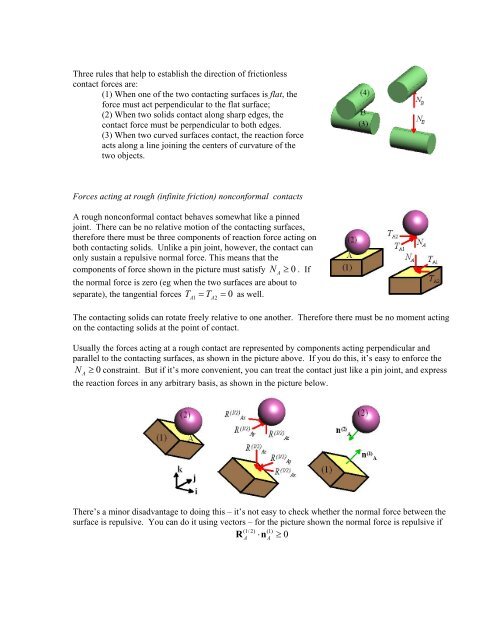Chapter 2 Review of Forces and Moments - Brown University
Chapter 2 Review of Forces and Moments - Brown University
Chapter 2 Review of Forces and Moments - Brown University
You also want an ePaper? Increase the reach of your titles
YUMPU automatically turns print PDFs into web optimized ePapers that Google loves.
Three rules that help to establish the direction <strong>of</strong> frictionless<br />
contact forces are:<br />
(1) When one <strong>of</strong> the two contacting surfaces is flat, the<br />
force must act perpendicular to the flat surface;<br />
(2) When two solids contact along sharp edges, the<br />
contact force must be perpendicular to both edges.<br />
(3) When two curved surfaces contact, the reaction force<br />
acts along a line joining the centers <strong>of</strong> curvature <strong>of</strong> the<br />
two objects.<br />
<strong>Forces</strong> acting at rough (infinite friction) nonconformal contacts<br />
A rough nonconformal contact behaves somewhat like a pinned<br />
joint. There can be no relative motion <strong>of</strong> the contacting surfaces,<br />
therefore there must be three components <strong>of</strong> reaction force acting on<br />
both contacting solids. Unlike a pin joint, however, the contact can<br />
only sustain a repulsive normal force. This means that the<br />
components <strong>of</strong> force shown in the picture must satisfy N<br />
A<br />
≥ 0 . If<br />
the normal force is zero (eg when the two surfaces are about to<br />
separate), the tangential forces T<br />
1<br />
= T<br />
2<br />
= 0 as well.<br />
A<br />
A<br />
The contacting solids can rotate freely relative to one another. Therefore there must be no moment acting<br />
on the contacting solids at the point <strong>of</strong> contact.<br />
Usually the forces acting at a rough contact are represented by components acting perpendicular <strong>and</strong><br />
parallel to the contacting surfaces, as shown in the picture above. If you do this, it’s easy to enforce the<br />
N<br />
A<br />
≥ 0 constraint. But if it’s more convenient, you can treat the contact just like a pin joint, <strong>and</strong> express<br />
the reaction forces in any arbitrary basis, as shown in the picture below.<br />
There’s a minor disadvantage to doing this – it’s not easy to check whether the normal force between the<br />
surface is repulsive. You can do it using vectors – for the picture shown the normal force is repulsive if<br />
(1/ 2) (1)<br />
R ⋅n<br />
≥ 0<br />
A<br />
A
















